Investigation of Fracturing Fluid Flowback in Hydraulically Fractured Formations Based on Microscopic Visualization Experiments
Abstract
:1. Introduction
2. Materials and Methods
2.1. Experimental Materials and Fluid Properties
2.2. Microscopic Model Fabrication
2.3. Experimental Setup and Procedure
- Evacuate the microscopic model for 1 h to prevent other gases from entering the model [24];
- The HPLC pump was used to inject fracturing fluid into the microscopic model at a rate of 5 μL/min, and the pump was stopped when the model was completely saturated;
- The nitrogen gas was injected into the microscopic model under different pressure differences (from 0.1 to 0.5 MPa), then observe and record the retention and distribution of the liquid phase in the microscopic model at each pressure, and close the nitrogen cylinder when there was no longer any significant change;
- Clean the model and repeat steps 1–3 after changing the fracturing fluid concentration and adjusting the nitrogen injection pressure.
2.4. Image Processing
3. Results
4. Discussion
4.1. Retention Mechanism of Fracturing Fluid in the Micromodel
- Viscous retention occurs when the fracturing fluid adheres to the solid phase surface due to the force of viscosity, as shown in Figure 12a;
- As the pore radius changes, the fracturing fluid is not easily displaced at the smaller pore throat due to the Jamin effect (The presence of bubbles can retard the flow of water as it progresses through the pore throat of small diameter. The Jamin effect is defined as the resistance to flow under pressure through the smaller pore throat [27]), as shown in Figure 12b;
- The gas blockage effect (At the same pressure gradient, the gas flows faster than the liquid due to its lower viscosity and the relative permeability of the gas phase is higher in the porous media; once the gas phase controls the flow passages to the main fracture/wellbore, the liquid phase may not be able to flow as it is blocked by the gas) causes the fracturing fluid to be trapped and unable to flow, thus resulting in the fracturing fluid being retained at the pore wall, as shown in Figure 12c;
- The fracturing fluid becomes confined in the dead end, as shown in Figure 12d.
4.1.1. Viscous Force
4.1.2. Capillary Force
4.2. Flowback Efficiency and Capillary Number
- (1)
- The ultimate fracturing fluid flowback efficiencies decreased as the fracturing fluid concentration increased;
- (2)
- The ultimate fracturing fluid flowback efficiencies increased as the gas driving pressure differences increased, and this phenomenon was more obvious in the high concentration fracturing fluid.
5. Conclusions
- (1)
- In the early stages of fracturing fluid flowback, flowback efficiency increases rapidly and then plateaus. The ultimate fracturing fluid flowback efficiencies decreased as the concentration increased or the gas driving pressure differences decreased.
- (2)
- There are four kinds of mechanisms responsible for fracturing fluid retention in the pore network: viscous resistance, the Jamin effect, the gas blockage effect and the dead end of the pore. The viscous force and the capillary force are two important resistances to the fracturing fluid flowback process.
- (3)
- The ultimate flowback efficiency of the fracturing fluid increases linearly with increasing capillary number. At very low capillary numbers, capillary forces dominate fracturing fluid retention.
Supplementary Materials
Author Contributions
Funding
Institutional Review Board Statement
Data Availability Statement
Conflicts of Interest
Appendix A
| Concentration (wt%) | Interfacial Tension (mN·m−1) | Contact Angle (°) | Flow Rate (m/s) | Capillary Number |
|---|---|---|---|---|
| 0.1 | 54.5 | 35.02 | 2.185 × 10−3 | 8.6008 × 10−7 |
| 2.790 × 10−3 | 1.0983 × 10−6 | |||
| 4.232 × 10−3 | 1.6660 × 10−6 | |||
| 0.8 | 72.9 | 38.49 | 1.219 × 10−3 | 3.7534 × 10−7 |
| 2.351 × 10−3 | 7.2407 × 10−7 | |||
| 2.934 × 10−3 | 9.0370 × 10−7 | |||
| 1.2 | 87.7 | 50.50 | 1.510 × 10−4 | 4.7528 × 10−8 |
| 2.028 × 10−3 | 6.3876 × 10−7 | |||
| 1.135 × 10−2 | 3.5754 × 10−6 |
References
- Zhao, X.; Kang, B.; Lan, B. Focus on the development of shale gas in China—Based on SWOT analysis. Renew. Sustain. Energy Rev. 2013, 21, 603–613. [Google Scholar] [CrossRef]
- National Energy Administration. Shale Gas Development Planning (2016–2020). Available online: http://zfxxgk.nea.gov.cn/auto86/201609/t20160930_2306.htm?keywords (accessed on 14 September 2016).
- U.S. Energy Information Administration (EIA). Shale Gas Production Drives World Natural Gas Production Growth. Available online: https://www.eia.gov/todayinenergy/detail.php?id=27512 (accessed on 15 August 2016).
- U.S. Energy Information Administration (EIA). Annual Energy Outlook 2016 with Projections to 2040. Available online: www.eia.gov/forecasts/aeo/pdf/0383(2016).pdf (accessed on 20 March 2016).
- U.S. Energy Information Administration (EIA). Argentina Seeking Increased Natural Gas Production from Shale Resources to Reduce Imports. Available online: https://www.eia.gov/todayinenergy/detail.php?id=29912 (accessed on 10 February 2017).
- Haluszczak, L.O.; Rose, A.W.; Kump, L.R. Geochemical evaluation of flowback brine from Marcellus gas wells in Pennsylvania, USA. Appl. Geochem. 2013, 28, 55–61. [Google Scholar] [CrossRef]
- You, L.; Xie, B.; Yang, J.; Kang, Y.; Han, H.; Wang, L.; Yang, B. Mechanism of fracture damage induced by fracturing fluid flowback in shale gas reservoirs. Nat. Gas Ind. B 2019, 6, 366–373. [Google Scholar] [CrossRef]
- Al-Hajri, S.; Negash, B.M.; Rahman, M.; Haroun, M.; Al-Shami, T.M. Perspective Review of Polymers as Additives in Water-Based Fracturing Fluids. ACS Omega 2022, 7, 7431–7443. [Google Scholar] [CrossRef]
- Crafton, J.W. Modeling Flowback Behavior or Flowback Equals Slowback. In Proceedings of the SPE Shale Gas Production Conference, Fort Worth, TX, USA, 16–18 November 2008; OnePetro: Fort Worth, TX, USA, 2008. [Google Scholar] [CrossRef]
- Clarkson, C.R.; Williams-Kovacs, J.D. Modeling two-phase flowback of multifractured horizontal wells completed in shale. SPE J. 2013, 18, 795–812. [Google Scholar] [CrossRef]
- Jia, P.; Cheng, L.; Clarkson, C.R.; Williams-Kovacs, J.D. Flow behavior analysis of two-phase (gas/water) flowback and early-time production from hydraulically-fractured shale gas wells using a hybrid numerical/analytical model. Int. J. Coal Geol. 2017, 182, 14–31. [Google Scholar] [CrossRef]
- Gao, S.; Hu, Z.; Guo, W.; Zuo, L.; Shen, R. Water absorption characteristics of gas shale and the fracturing fluid flowback capacity. Nat. Gas Ind. 2013, 33, 71–76. [Google Scholar]
- Da, Q.-A.; Yao, C.-J.; Zhang, X.; Wang, X.-P.; Qu, X.-H.; Lei, G.-L. Investigation on microscopic invasion characteristics and retention mechanism of fracturing fluid in fractured porous media. Pet. Sci. 2022, 19, 1745–1756. [Google Scholar] [CrossRef]
- Tangirala, S.; Sheng, J.J. Investigation of oil production and flowback in hydraulically-fractured water-wet formations using the Lab-on-a-Chip method. Fuel 2019, 254, 115543. [Google Scholar] [CrossRef]
- Lenormand, R.; Touboul, E.; Zarcone, C. Numerical models and experiments on immiscible displacements in porous media. J. Fluid Mech. 1988, 189, 165–187. [Google Scholar] [CrossRef]
- Wijaya, N.; Sheng, J.J. Surfactant selection criteria with flowback efficiency and oil recovery considered. J. Pet. Sci. Eng. 2020, 192, 107305. [Google Scholar] [CrossRef]
- Tian, J.; Qin, C.; Kang, Y.; You, L.; Jia, N.; Song, J. Reasons for low flowback behaviors of water-based fluids in tight sandstone gas reservoirs. J. Pet. Sci. Eng. 2023, 220, 111152. [Google Scholar] [CrossRef]
- Li, J.; Su, H.; Jiang, H.; Yu, F.; Liang, T.; Zhao, Y.; Gao, Y.; Hejazi, H. Application of microfluidic models in the oil and gas field development. Pet. Sci. Bull. 2018, 3, 284–301. [Google Scholar] [CrossRef]
- Pan, B.; Clarkson, C.R.; Debuhr, C.; Younis, A.; Song, C.; Ghanizadeh, A.; Birss, V.I. Low-permeability reservoir sample wettability characterization at multiple scales: Pore-, micro-and macro-contact angles. J. Nat. Gas Sci. Eng. 2021, 95, 104229. [Google Scholar] [CrossRef]
- Wu, M.; Xiao, F.; Johnson-Paben, R.M.; Retterer, S.T.; Yin, X.; Neeves, K.B. Single-and two-phase flow in microfluidic porous media analogs based on Voronoi tessellation. Lab Chip 2012, 12, 253–261. [Google Scholar] [CrossRef] [PubMed]
- Pan, B.; Clarkson, C.R.; Atwa, M.; Debuhr, C.; Ghanizadeh, A.; Birss, V.I. Wetting dynamics of nanoliter water droplets in nanoporous media. J. Colloid Interface Sci. 2021, 589, 411–423. [Google Scholar] [CrossRef]
- He, F.; Wang, J. Study on the causes of water blocking damage and its solutions in gas reservoirs with microfluidic technology. Energies 2022, 15, 2684. [Google Scholar] [CrossRef]
- Wu, Y.-N.; Tang, L.-S.; Li, Y.; Zhang, L.-Y.; Jin, X.; Zhao, M.-W.; Feng, X.; Dai, C.-L. Probing the influence of secondary fracture connectivity on fracturing fluid flowback efficiency. Pet. Sci. 2022. [Google Scholar] [CrossRef]
- Wang, X.; Zhu, W.; Li, H.; Song, Z. Pore-scale mechanisms of the synergistic effects between microbial cultures and chemical surfactants on oil recovery. Energy Fuels 2018, 32, 12319–12327. [Google Scholar] [CrossRef]
- Xu, W.; Ok, J.T.; Xiao, F.; Neeves, K.B.; Yin, X. Effect of pore geometry and interfacial tension on water-oil displacement efficiency in oil-wet microfluidic porous media analogs. Phys. Fluids 2014, 26, 093102. [Google Scholar] [CrossRef]
- He, K.; Xu, L.; Gao, Y.; Yin, X.; Neeves, K.B. Evaluation of surfactant performance in fracturing fluids for enhanced well productivity in unconventional reservoirs using Rock-on-a-Chip approach. J. Pet. Sci. Eng. 2015, 135, 531–541. [Google Scholar] [CrossRef] [Green Version]
- Song, H.; Liu, Q.; Yang, D.; Yu, M.; Lou, Y.; Zhu, W. Productivity equation of fractured horizontal well in a water-bearing tight gas reservoir with low-velocity non-Darcy flow. J. Nat. Gas Sci. Eng. 2014, 18, 467–473. [Google Scholar] [CrossRef]
- Yu, X.; Li, Y.; Liu, Y.; Yang, Y.; Wu, Y. Flow Patterns of Viscoelastic Fracture Fluids in Porous Media: Influence of Pore-Throat Structures. Polymers 2019, 11, 1291. [Google Scholar] [CrossRef] [PubMed] [Green Version]
- Iferobia, C.C.; Ahmad, M.; Ali, I. Experimental Investigation of Shale Tensile Failure under Thermally Conditioned Linear Fracturing Fluid (LFF) System and Reservoir Temperature Controlled Conditions. Polymers 2022, 14, 2417. [Google Scholar] [CrossRef] [PubMed]
- Guo, C.; Xu, J.; Wu, K.; Wei, M.; Liu, S. Study on gas flow through nano pores of shale gas reservoirs. Fuel 2015, 143, 107–117. [Google Scholar] [CrossRef]
- Tokunaga, T.; Mogi, K.; Matsubara, O.; Tosaka, H.; Kojima, K. Buoyancy and interfacial force effects on two-phase displacement patterns: An experimental study. AAPG Bull. 2000, 84, 65–74. [Google Scholar] [CrossRef]
- Wilkinson, D. Percolation model of immiscible displacement in the presence of buoyancy forces. Phys. Rev. A 1984, 30, 520. [Google Scholar] [CrossRef]
- Wilkinson, D. Percolation effects in immiscible displacement. Phys. Rev. A 1986, 34, 1380. [Google Scholar] [CrossRef]
- He, K.; Xu, L.; Kenzhekhanov, S.; Yin, X.; Neeves, K.B. A rock-on-a-chip approach to study fluid invasion and flowback in liquids-rich shale formations. In Proceedings of the SPE Oklahoma City Oil and Gas Symposium, Oklahoma City, OK, USA, 27–31 March 2017; OnePetro: Fort Worth, TX, USA, 2017. [Google Scholar] [CrossRef]
- AlQuaimi, B.I.; Rossen, W.R. Capillary desaturation curve for residual nonwetting phase in natural fractures. SPE J. 2018, 23, 788–802. [Google Scholar] [CrossRef]
- Yeganeh, M.; Hegner, J.; Lewandowski, E.; Mohan, A.; Lake, L.W.; Cherney, D.; Jusufi, A.; Jaishankar, A. Capillary desaturation curve fundamentals. In Proceedings of the SPE Improved Oil Recovery Conference, Tulsa, OK, USA, 11–13 April 2016; OnePetro: Fort Worth, TX, USA, 2016. [Google Scholar] [CrossRef]
- de Castro, A.R.; Shokri, N.; Karadimitriou, N.; Oostrom, M.; Joekar-Niasar, V. Experimental study on nonmonotonicity of Capillary Desaturation Curves in a 2-D pore network. Water Resour. Res. 2015, 51, 8517–8528. [Google Scholar] [CrossRef]


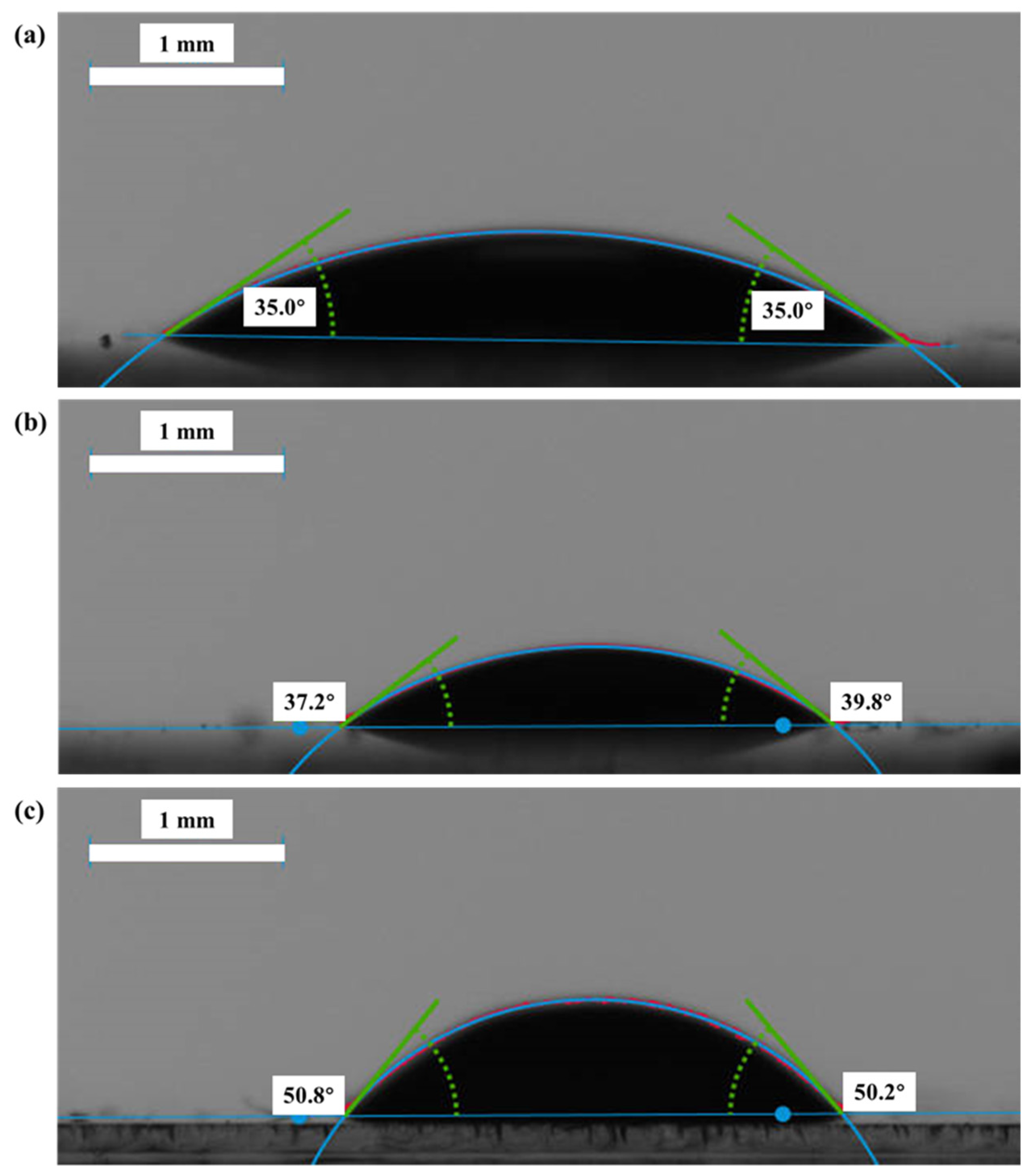
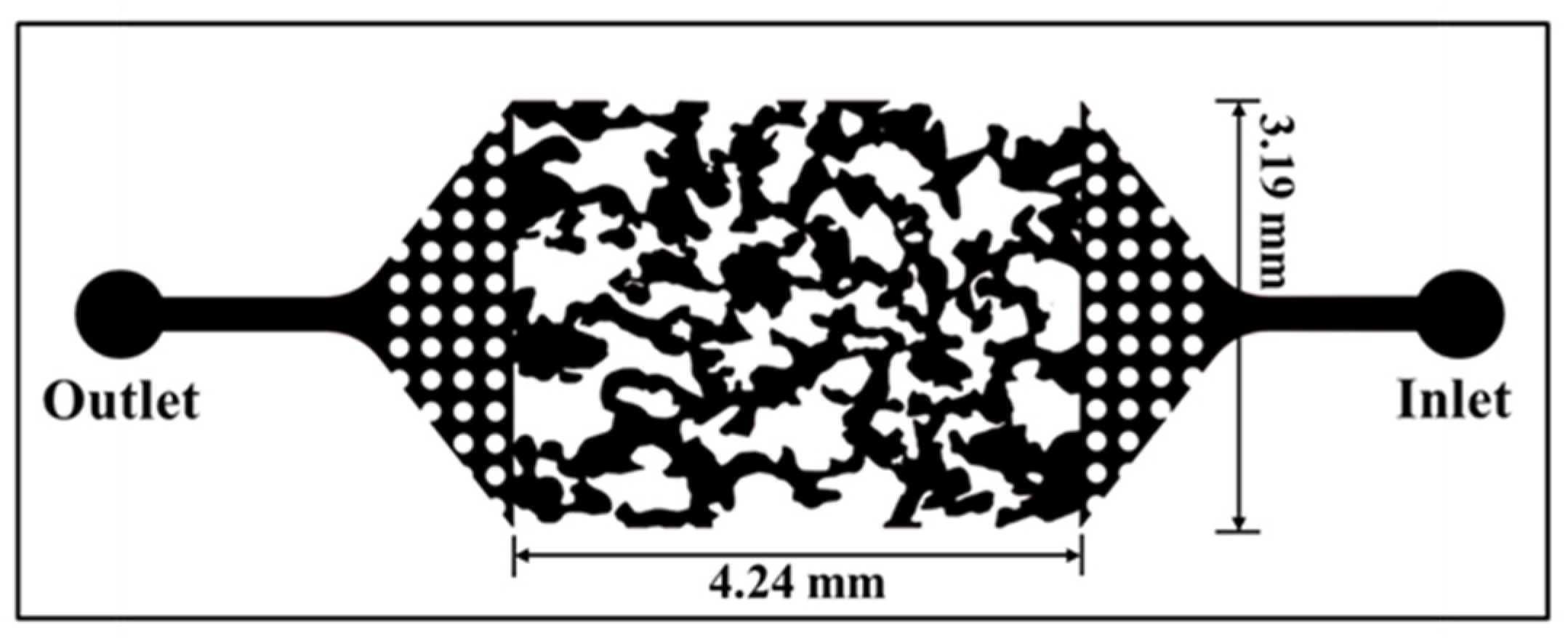
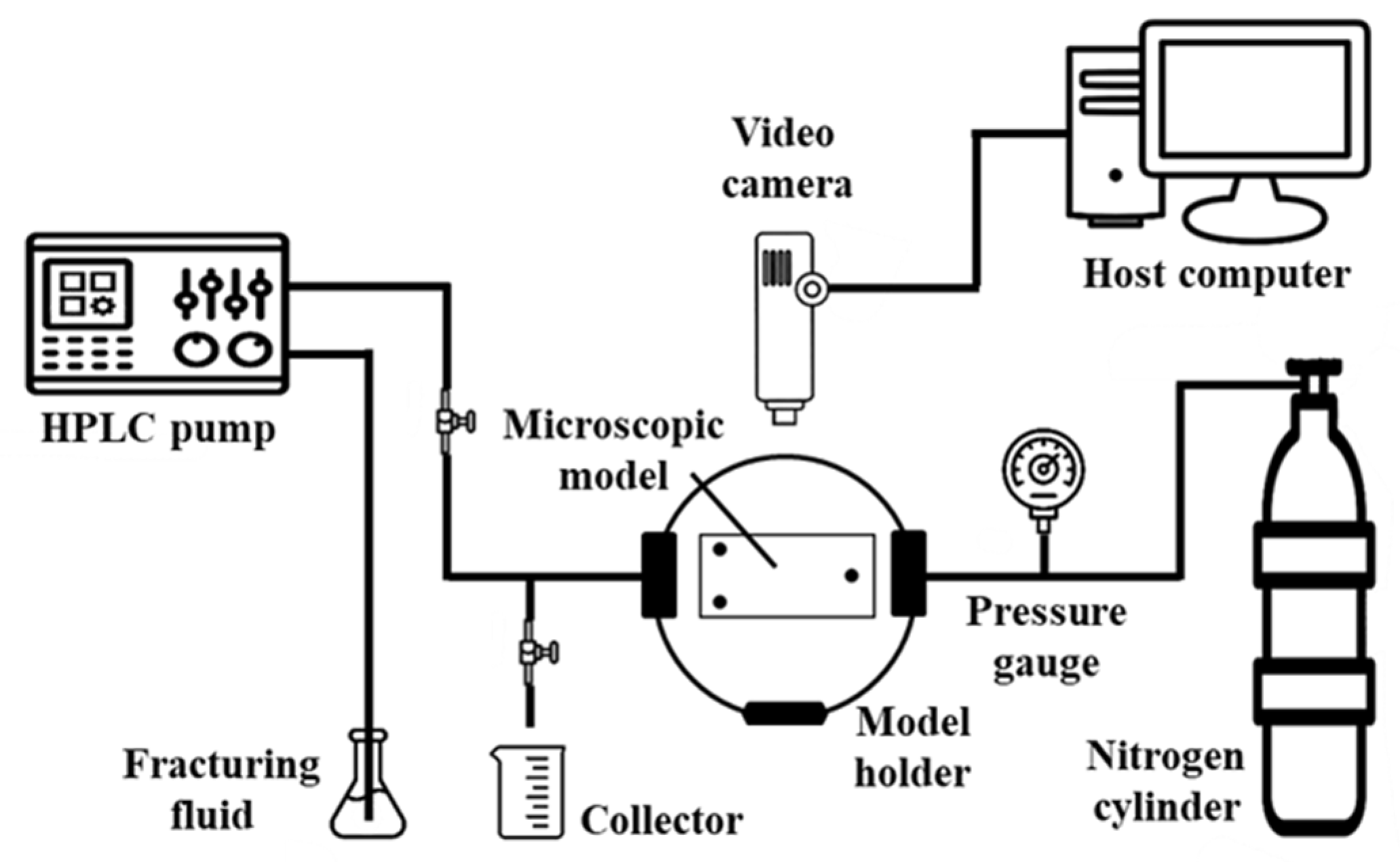

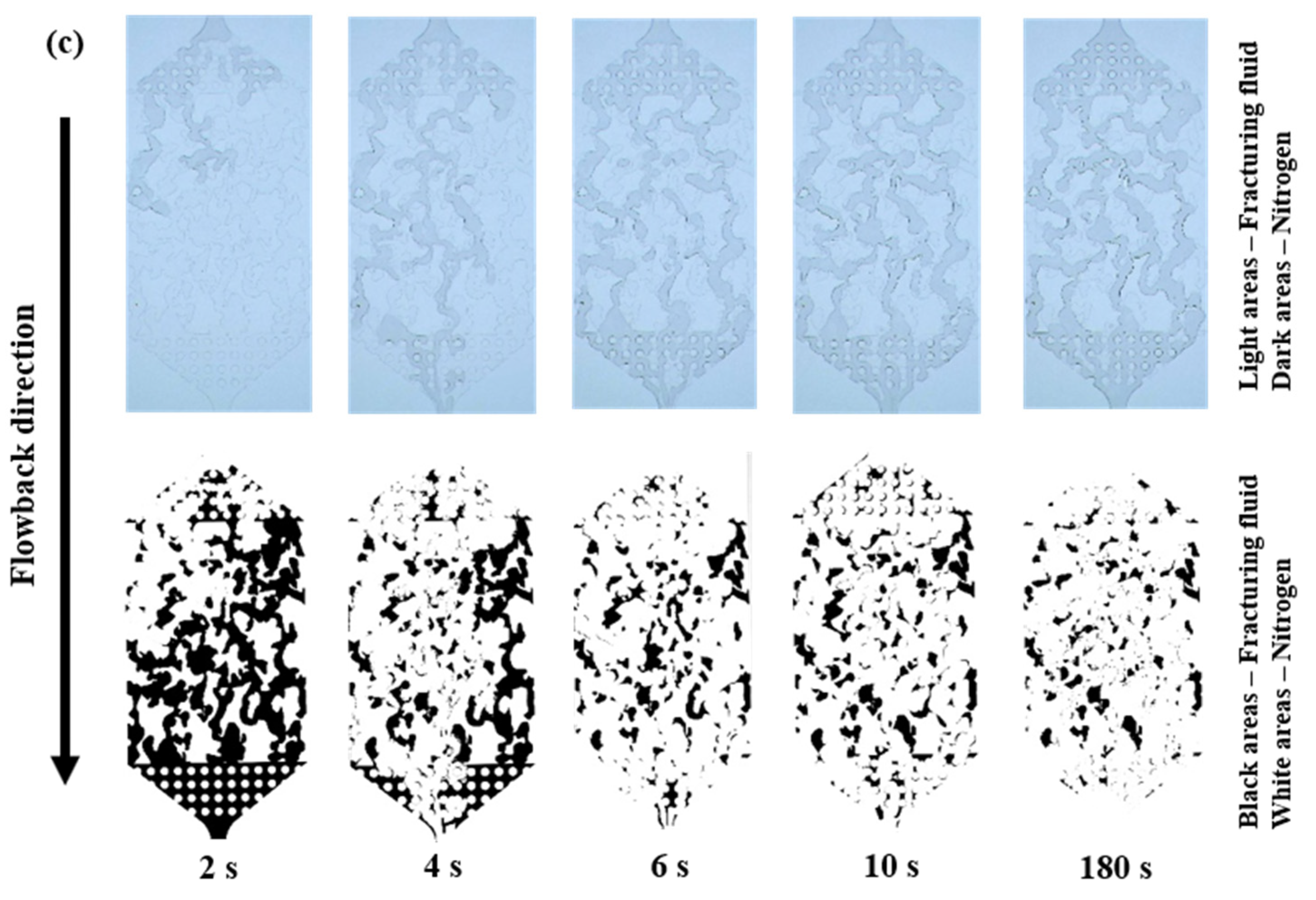
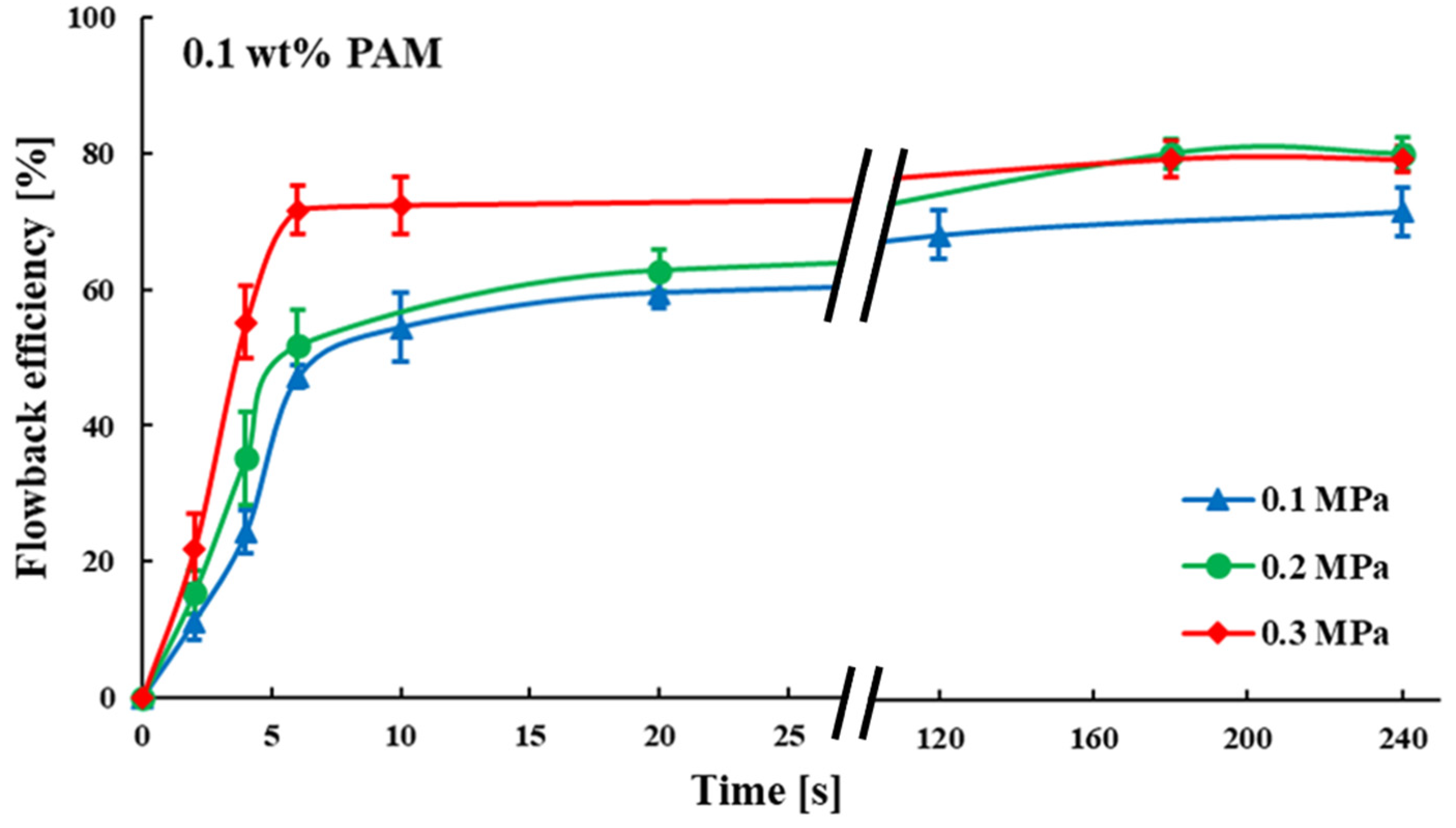

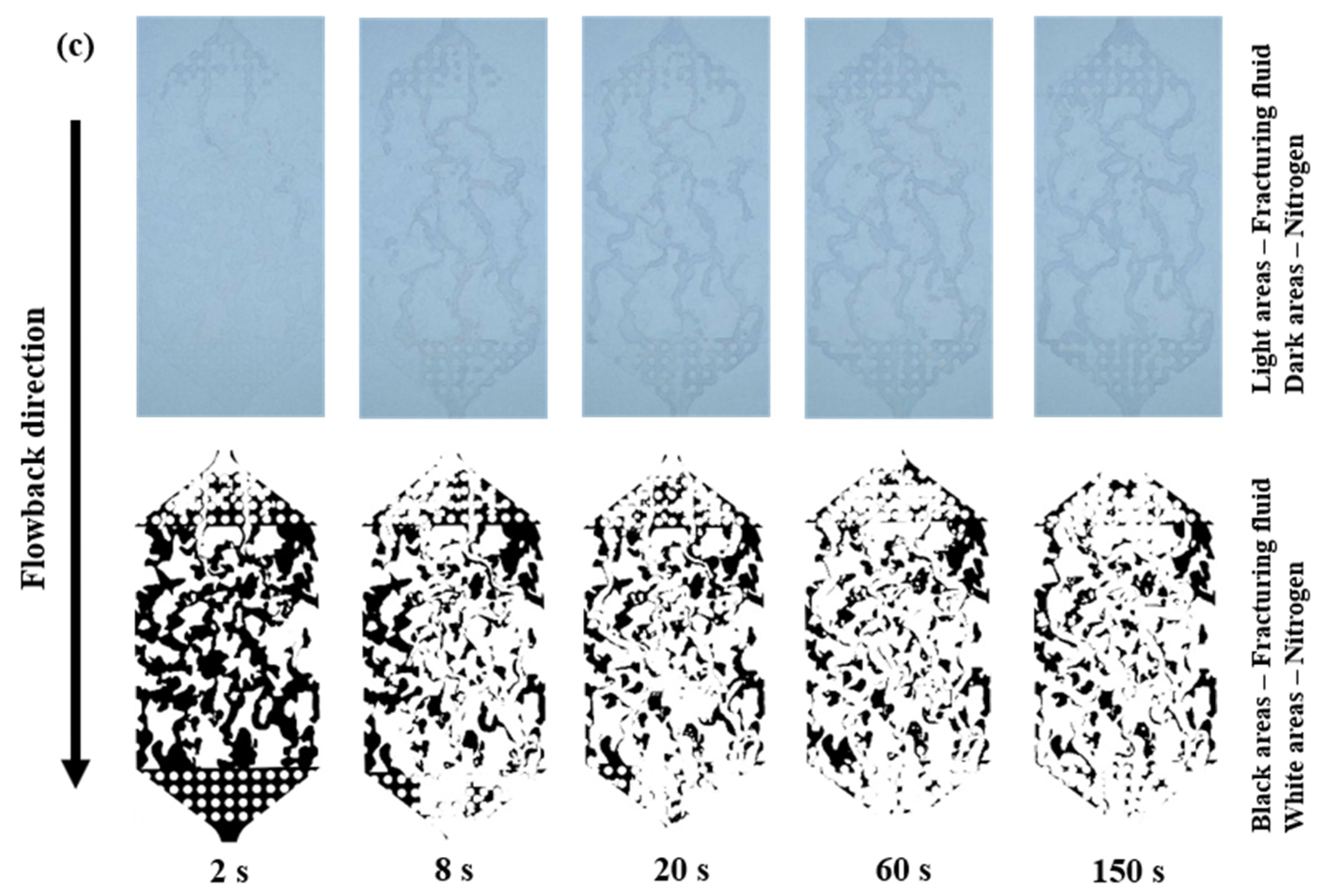


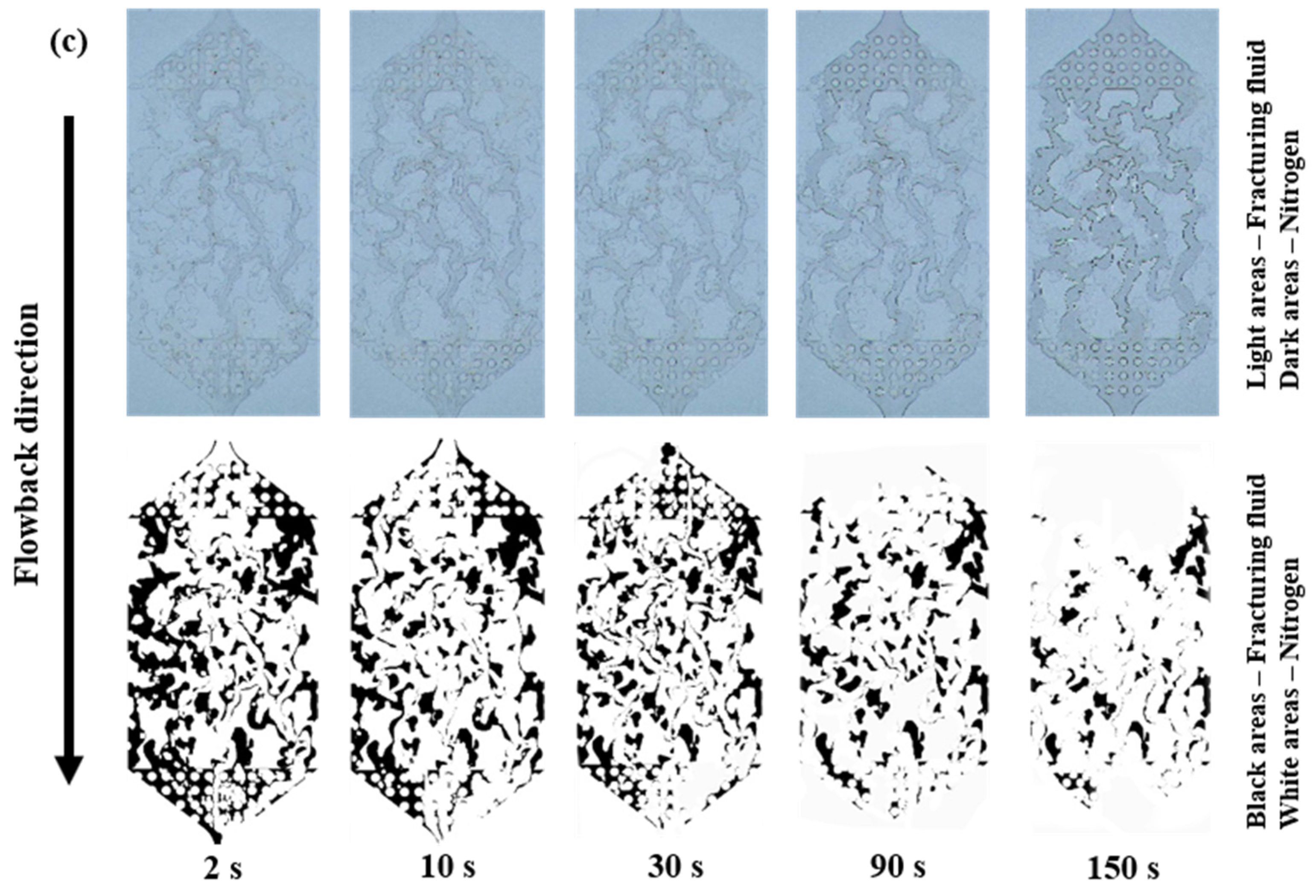

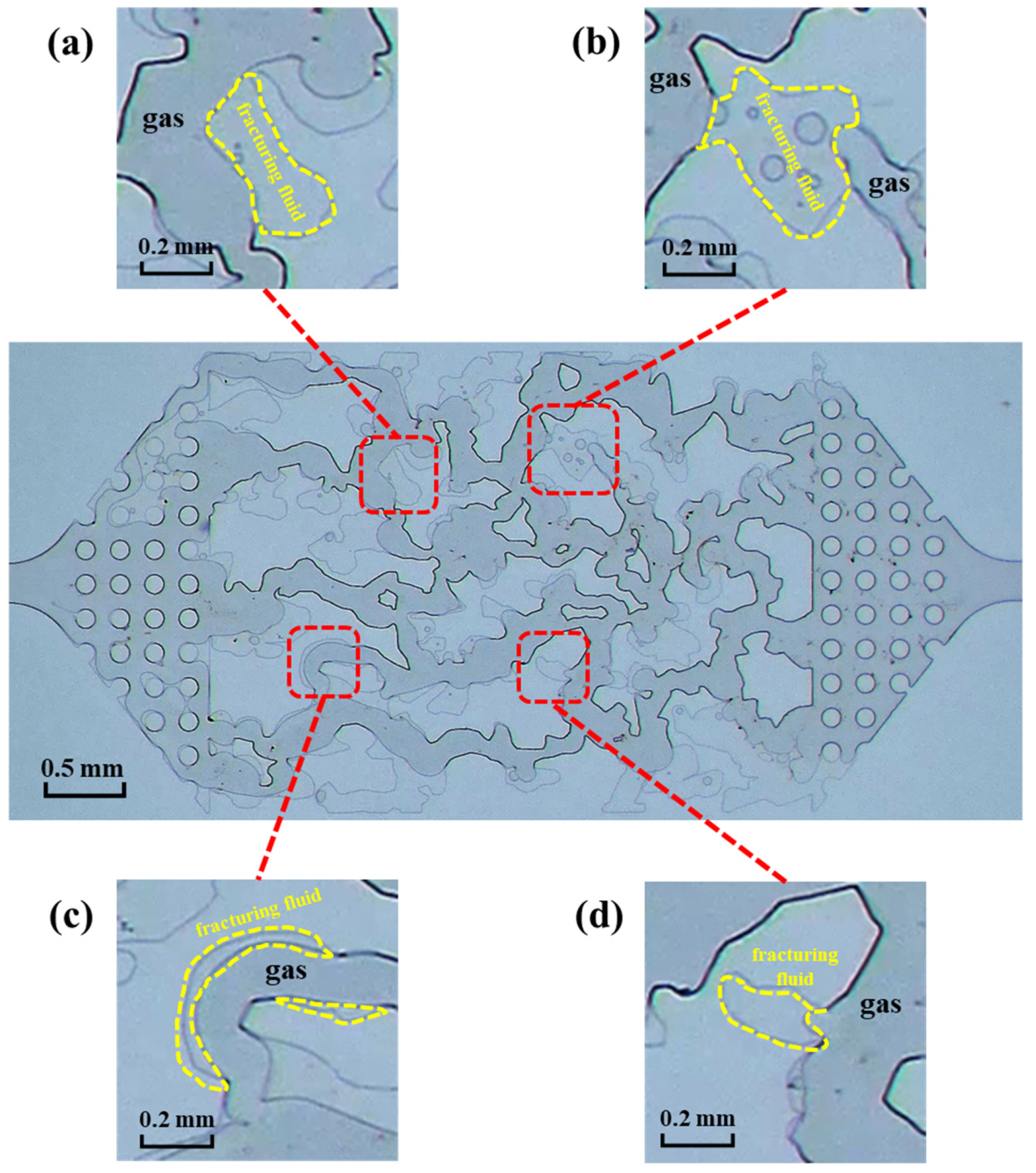
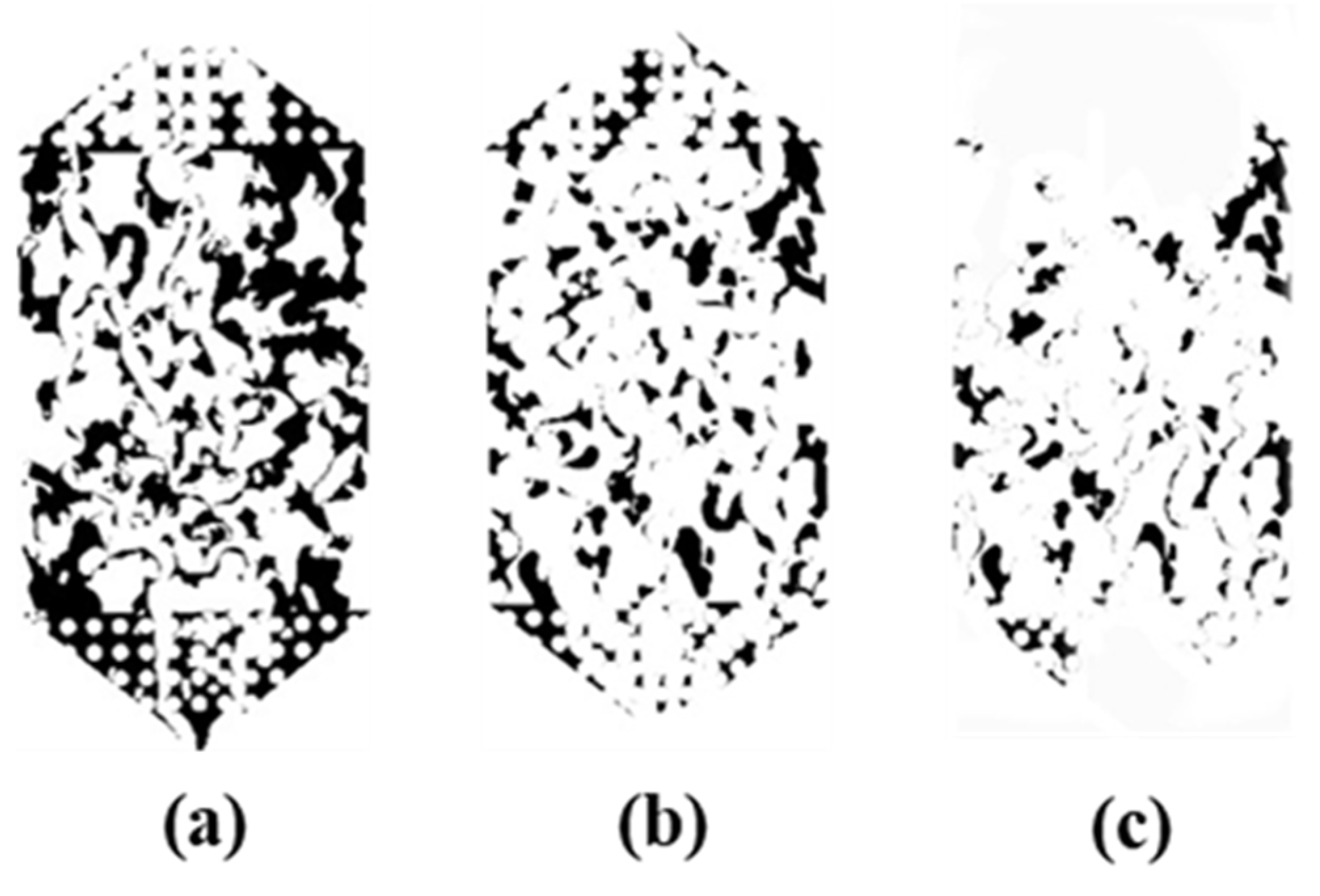


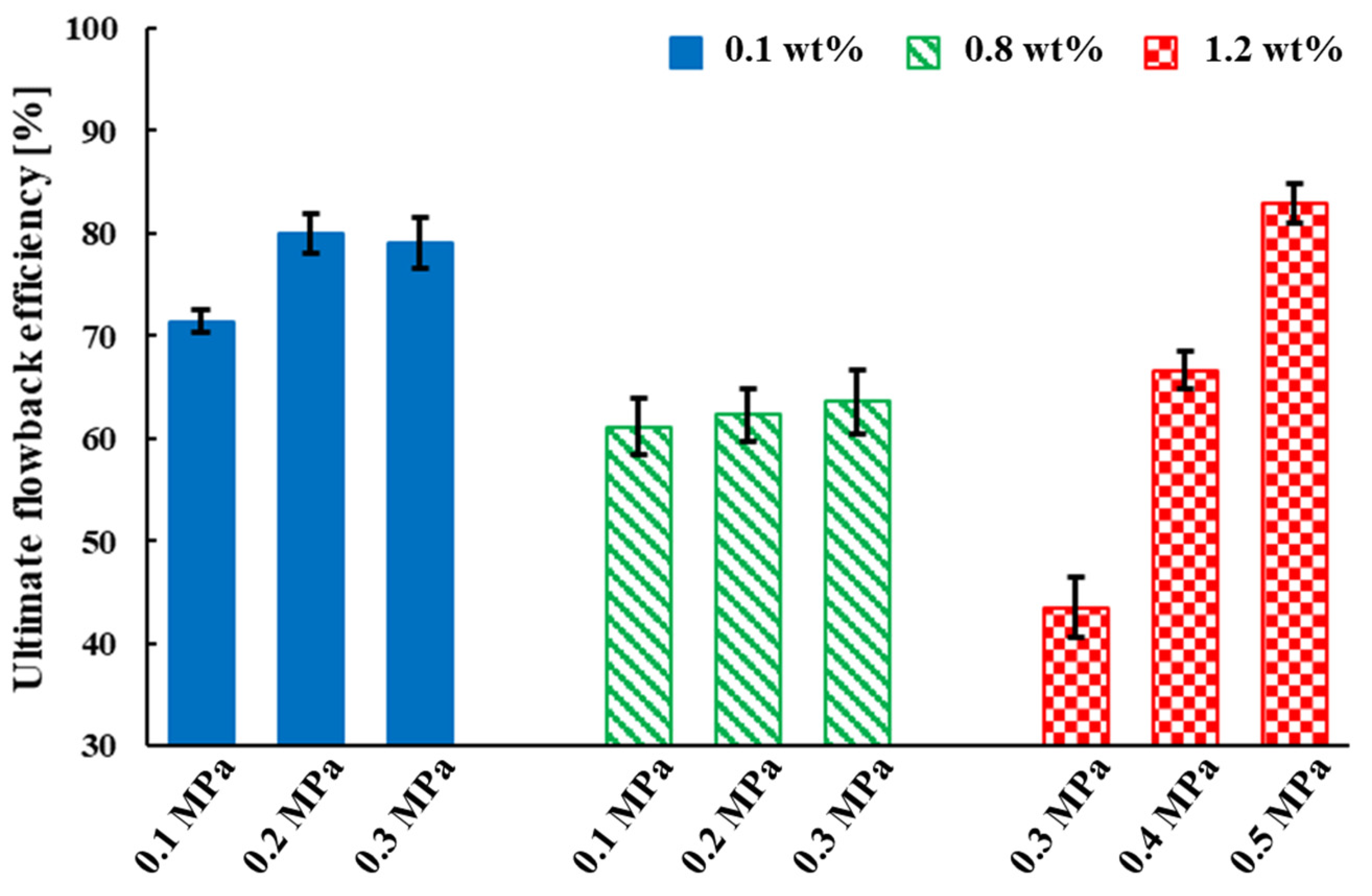
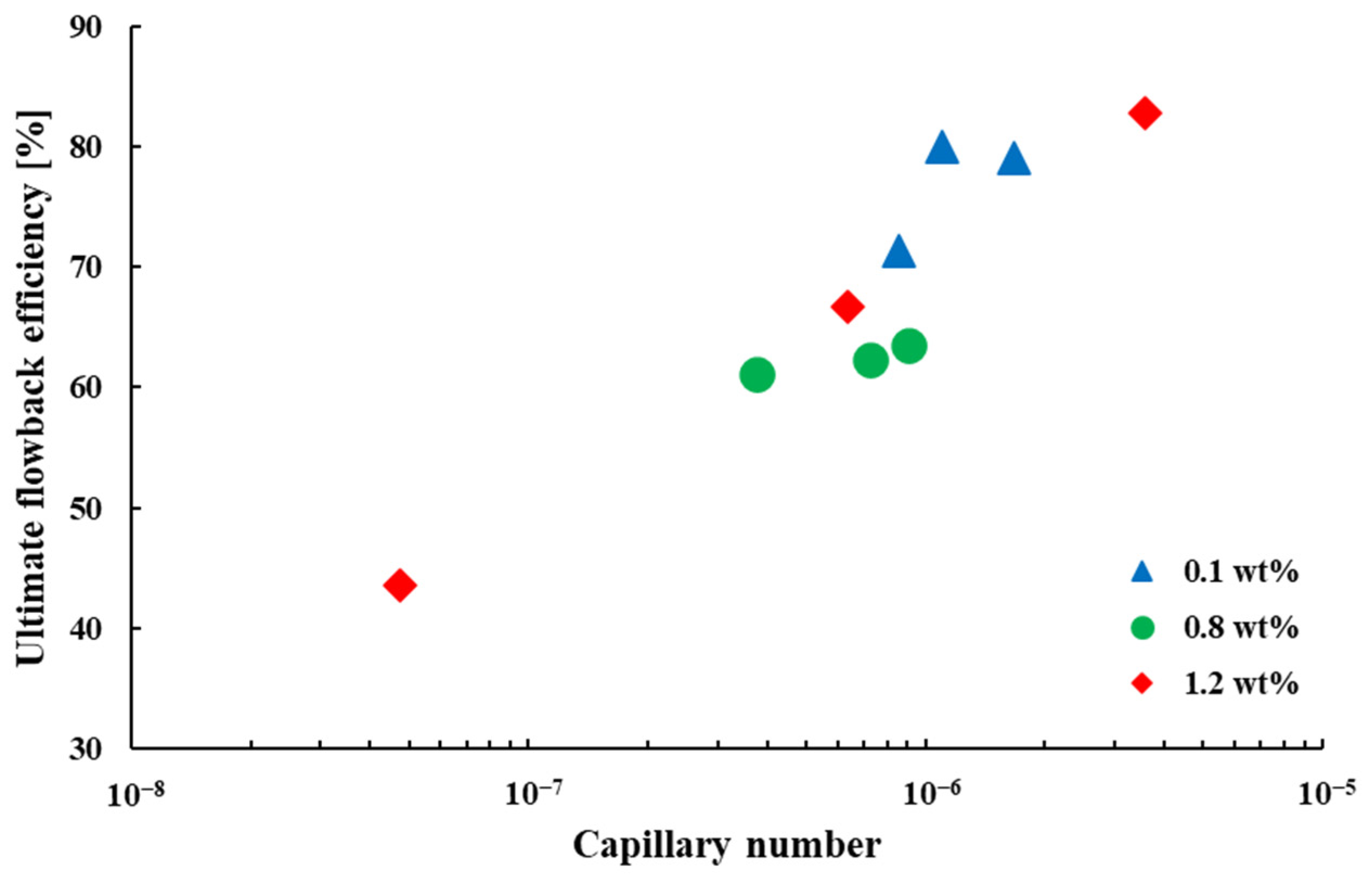
| Polymer | Functional Profile |
|---|---|
| Polyacrylamide (PAM) | increases viscosity and thickness to enhance hydraulic effect and reduce fluid loss |
| Hydroxyethyl Cellulose (HEC) | increases viscosity and gel properties to prevent fluid loss and enhance fracture formation |
| Cellulose | increases viscosity and gel properties to improve rheological properties and shear resistance |
| Polyamide Gel (PAG) | prevent fluid loss and enhance fracture stability |
| Polyvinyl Alcohol (PVA) | increases viscosity and gel properties to prevent fluid loss and enhance fracture formation |
| Comparison Item | Water-Based Fracturing Fluid | Silicate-Based Fracturing Fluid |
|---|---|---|
| Composition | Water and some additives, such as viscosity agents, dispersants, emulsifiers, etc. | Chemicals such as water glass, silicates, phosphates, etc. |
| Application Range | Suitable for softer and more brittle formations, such as shale gas, shale oil, tight oil, etc. | Suitable for harder and more dense formations, such as sandstone, conglomerate, limestone, etc. |
| Fracturing Effect | Forms certain porosity to increase rock permeability during the fracturing process | Generates chemical reactions with formation minerals to produce gels, increasing formation strength and stability |
| Environmental Friendliness | Relatively more environmentally friendly, with lower risk of groundwater and environmental pollution | Has a greater impact on the environment because it contains chemicals |
| Concentration (wt%) | Viscosity (mPa·s) | Interfacial Tension (mN·m−1) | Contact Angle (°) |
|---|---|---|---|
| 0.1 | 7.1 | 54.5 | 35.02 |
| 0.8 | 62.7 | 72.9 | 38.49 |
| 1.2 | 96.1 | 87.7 | 50.50 |
| Concentration (wt%) | Viscosity (mPa·s) | Gas Driving Pressure Difference (MPa) | Sf (%) | FB (%) |
|---|---|---|---|---|
| 0.1 | 7.1 | 0.1 | 28.58 | 71.42 |
| 0.2 | 20.01 | 79.99 | ||
| 0.3 | 20.89 | 79.11 | ||
| 0.8 | 62.7 | 0.1 | 38.84 | 61.16 |
| 0.2 | 37.69 | 62.31 | ||
| 0.3 | 36.43 | 63.57 | ||
| 1.2 | 96.1 | 0.3 | 56.48 | 43.52 |
| 0.4 | 33.34 | 66.66 | ||
| 0.5 | 17.14 | 82.86 |
Disclaimer/Publisher’s Note: The statements, opinions and data contained in all publications are solely those of the individual author(s) and contributor(s) and not of MDPI and/or the editor(s). MDPI and/or the editor(s) disclaim responsibility for any injury to people or property resulting from any ideas, methods, instructions or products referred to in the content. |
© 2023 by the authors. Licensee MDPI, Basel, Switzerland. This article is an open access article distributed under the terms and conditions of the Creative Commons Attribution (CC BY) license (https://creativecommons.org/licenses/by/4.0/).
Share and Cite
Zou, G.; Pan, B.; Zhu, W.; Liu, Y.; Ma, S.; Liu, M. Investigation of Fracturing Fluid Flowback in Hydraulically Fractured Formations Based on Microscopic Visualization Experiments. Polymers 2023, 15, 1560. https://doi.org/10.3390/polym15061560
Zou G, Pan B, Zhu W, Liu Y, Ma S, Liu M. Investigation of Fracturing Fluid Flowback in Hydraulically Fractured Formations Based on Microscopic Visualization Experiments. Polymers. 2023; 15(6):1560. https://doi.org/10.3390/polym15061560
Chicago/Turabian StyleZou, Guodong, Bin Pan, Weiyao Zhu, Yuwei Liu, Shou Ma, and Mingming Liu. 2023. "Investigation of Fracturing Fluid Flowback in Hydraulically Fractured Formations Based on Microscopic Visualization Experiments" Polymers 15, no. 6: 1560. https://doi.org/10.3390/polym15061560





